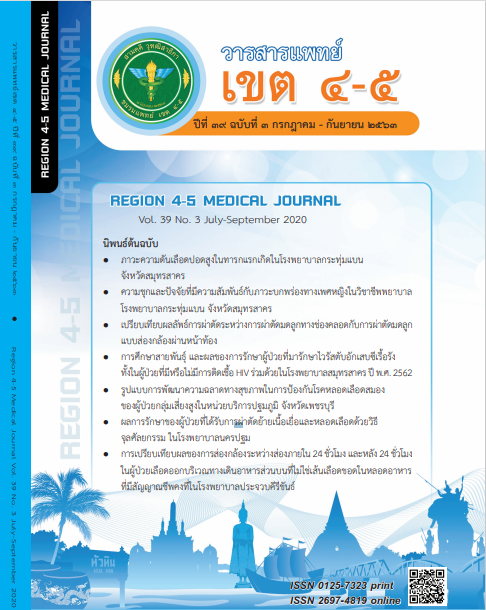ความชุกของโรคทางผิวหนังในโรงพยาบาลไทรน้อย
คำสำคัญ:
ความชุก, โรคผิวหนัง, โรคทางผิวหนังบทคัดย่อ
ปัญหาทางโรคผิวหนังเป็นปัญหาที่ได้รับการยอมรับมากขึ้นในระยะหลังว่าส่งผลโดยตรงต่อคุณภาพชีวิตของผู้ป่วย มีผลทั้งโดยตัวบุคคลและต่อสังคม การรับทราบข้อมูลที่ถูกต้องในด้านจำนวนตลอดจนความชุกของโรคจึงเป็นเรื่องสำคัญ ในอำเภอไทรน้อยมีผู้เข้ารับบริการด้วยปัญหาโรคผิวหนังเป็นจำนวนไม่น้อย แต่ยังไม่มีการศึกษาถึงความชุกของโรค จึงได้เกิดการศึกษานี้ขึ้น
วัตถุประสงค์: เพื่อศึกษาหาความชุกของโรคผิวหนังของผู้เข้ารับบริการแผนกผู้ป่วยนอกของโรงพยาบาลไทรน้อย
วิธีการศึกษา: ศึกษาเชิงพรรณนา (descriptive study) โดยการเก็บข้อมูลย้อนหลัง ตั้งแต่วันที่ 1 มกราคม 2562 ถึง 31 ธันวาคม 2562 โดยมีวัตถุประสงค์เพื่อศึกษาหาความชุกของโรคทางผิวหนังของผู้เข้ารับบริการในโรงพยาบาลไทรน้อยที่มีอายุตั้งแต่ 15 ปีขึ้นไปทุกรายและได้การวินิจฉัยว่ามีโรคทางผิวหนัง โดยยึดข้อมูลจากการวินิจฉัยในโปรแกรมจัดการฐานข้อมูล HOSxP ของโรงพยาบาล แบ่งตาม ICD – 10 และนำมาจัดแบ่งเป็นกลุ่มโรค
ผลการศึกษา: จากประชากรชุมชมไทรน้อยทั้งหมด 65,750 คน มีผู้เข้ารับบริการแผนกผู้ป่วยนอกที่ได้รับการวินิจฉัยเป็นโรคทางผิวหนัง 5,948 คน คิดเป็นความชุกร้อยละ 9.046 โดยพบกลุ่มโรคติดเชื้อมากกว่าโรคไม่ติดเชื้ออยู่ที่ร้อยละ 5.426 และ 2.659 โดยหากแยกเป็นตัวโรค พบโรคที่มีความชุกสูงสุด 10 ลำดับแรก คือ 1.cellulitis ร้อยละ 2.546 โดยพบไม่ระบุตำแหน่งมากที่สุด ตามมาด้วย limbs และ buttock 2.carbuncle, furuncle and abscess ร้อยละ 3.334 3.dermatitis,unspecified ร้อยละ 0.887 4.dermatophytosis ร้อยละ 0.520 5.allergic contact dermatitis ร้อยละ 0.260 6.herpes zoster ร้อยละ 0.221 7.candidiasis ร้อยละ 0.204 8.herpes simplex ร้อยละ 0.128 9.epidermal cyst ร้อยละ 0.120 และ 10.decubitus ulcer ร้อยละ 0.102
สรุป: การศึกษานี้พบว่า ความชุกของโรคทางผิวหนังของผู้เข้ารับบริการแผนกผู้ป่วยนอกโรงพยาบาลไทรน้อย อยู่ที่ร้อยละ 9.1 โดยเป็นโรคติดเชื้อมากกว่าโรคไม่ติดเชื้อ โรคที่พบมากที่สุดสองลำดับแรกคือ cellulitis และ carbuncle, furuncle และ abscess ตามมาด้วย dermatitis,unspecified และ urticaria ซึ่งอยู่ในกลุ่มโรคไม่ติดเชื้อ ผลการศึกษาจึงสอดคล้องกับที่มีผู้ได้เคยทำการศึกษาก่อนหน้าว่า ความชุกของโรคทางผิวหนังของประเทศที่อยู่ในเขตร้อนพบในกลุ่มโรคติดเชื้อมากกว่าโรคไม่ติดเชื้อ
เอกสารอ้างอิง
2. Lewis V, Finlay AY. 10 years experience of the Dermatology Life Quality Index (DLQI). J Investig Dermatol Symp Proc 2004; 9(2): 169–80. doi: 10.1111/j.1087-0024.2004.09113.x.
3. Wolkenstein P, Grob JJ, Bastuji‐Garin S et al . French people and skin diseases: results of a survey using a representative sample. Arch Dermatol. 2003; 139(12): 1614–19; discussion 1619. doi: 10.1001/archderm.139.12.1614.
4. Svensson. Prevalence of skin disease in a population ‐ based sample of adults from five European countries. Br J Dermatol. 2018; 178(5): 1111-8. doi: 10.1111/bjd.16248.
5. Williams H, Robertson C, Stewart A et al . Worldwide variations in the prevalence of symptoms of atopic eczema in the International Study of Asthma and Allergies in Childhood. J Allergy Clin Immunol. 1999; 103(1 Pt 1): 125–38. doi: 10.1016/s0091-6749(99)70536-1.
6. Williams H, Stewart A, von Mutius E et al . Is eczema really on the increase worldwide?. J Allergy Clin Immunol. 2008; 121(947–54): e15. doi: 10.1016/j.jaci.2007.11.004.
7. Deckers IAG, McLean S, Linssen S et al . Investigating international time trends in the incidence and prevalence of atopic eczema 1990–2010: a systematic review of epidemiological studies. PLoS One. 2012; 7(7): e39803. doi: 10.1371/journal.pone.0039803
8. Naldi L, Cazzaniga S, Gonçalo M et al . Prevalence of self‐reported skin complaints and avoidance of common daily life consumer products in selected European Regions. JAMA Dermatol. 2014; 150(2): 154–63. doi: 10.1001/jamadermatol.2013.7932.
9. Tan J, Schöfer H, Araviiskaia E et al . Prevalence of rosacea in the general population of Germany and Russia – the RISE study. J Eur Acad Dermatol Venereology. 2016; 30(3): 428–34. doi: 10.1111/jdv.13556.
10. สถาบันโรคผิวหนัง กรมการแพทย์ กระทรวงสาธารณสุข ประเทศไทย, สถิติโรคผู้ป่วยนอก พ.ศ.2554 – 2556, 2559-2561.
11. Hay RJ, Johns NE, Williams HC et al . The global burden of skin disease in 2010: an analysis of the prevalence and impact of skin conditions. J Invest Dermatol. 2014; 134(6): 1527–34. doi: 10.1038/jid.2013.446
12. Borda LJ, Louis SJ, Fethiere M, et al Prevalence of Skin Disease in Urban Haiti: A Cross-Sectional Study. Dermatology. 2019; 235(6): 495-500. doi: 10.1159/000503061.
13. Arria M, Rodriguez-Morales AJ, Franco-Paredes C. Ecoepidemiología de las enfermedades tropicales en países de la cuenca Amazónica. Rev Peru Med Exp Salud Publica. 2005; 22: 236–40.
14. Gutierrez EL, Galarza C, Ramos W, et al. Skin diseases in the Peruvian Amazonia. Int J Dermatol. 2010; 49(7): 794–800. doi: 10.1111/j.1365-4632.2010.04473.x.
15. Kelly J, Chiaravalloti A. Prevalence of dermatologic disease in rural Haiti. J Am Acad Dermatol. 2014; 70(5): AB83. doi: https://doi.org/10.1016/j.jaad.2014.01.345
16. Mahé A, Cissé IAh, Faye O, et al. Skin diseases in Bamako (Mali). Int J Dermatol. 1998; 37(9): 673–6. doi: 10.1046/j.1365-4362.1998.00454.x.
17. Onayemi O, Isezuo SA, Njoku CH. Prevalence of different skin conditions in an outpatients’ setting in north-western Nigeria. Int J Dermatol. 2005; 44(1): 7–11. doi: 10.1111/j.1365-4632.2004.02298.x.
18. Doe PT, Asiedu A, Acheampong JW, et al. Skin diseases in Ghana and the UK. Int J Dermatol. 2001; 40(5): 323–6. doi: 10.1046/j.1365-4362.2001.01229.x.
19. Wiwanitkit V. Prevalence of dermatological disorders in Thai HIV‐infected patients correlated with different CD4 lymphocyte count statuses. Int J Dermatol. 2004; 43(4): 265–8. doi: 10.1111/j.1365-4632.2004.01649.x.
20. สำนักงานประกันสังคม กระทรวงแรงงาน. สถิติการเกิดโรคจากการทำงานในประเทศไทยปี พ.ศ. 2551. กรุงเทพมหานคร; 2551.
21. ประณีต สัจจเจริญพงษ์. โรคผิวหนังจากการทำงาน. ใน: อดุลย์ บัณฑุกุล, บรรณาธิการ. ตำราอาชีวเวชศาสตร์ (Textbook of occupational medicine). กรุงเทพฯ: โรงพยาบาลนพรัตนราชธานี กรมการแพทย์ กระทรวงสาธารณสุข; 2554. หน้า 667-89.
ดาวน์โหลด
เผยแพร่แล้ว
รูปแบบการอ้างอิง
ฉบับ
ประเภทบทความ
สัญญาอนุญาต
ลิขสิทธิ์บทความเป็นของผู้เขียนบทความ แต่หากผลงานของท่านได้รับการพิจารณาตีพิมพ์ลงวารสารแพทย์เขต 4-5 จะคงไว้ซึ่งสิทธิ์ในการตีพิมพ์ครั้งแรกด้วยเหตุที่บทความจะปรากฎในวารสารที่เข้าถึงได้ จึงอนุญาตให้นำบทความในวารสารไปใช้ประโยชน์ได้ในเชิงวิชาการโดยจำเป็นต้องมีการอ้างอิงถึงชื่อวารสารอย่างถูกต้อง แต่ไม่อนุญาตให้นำไปใช้ในเชิงพาณิชย์




